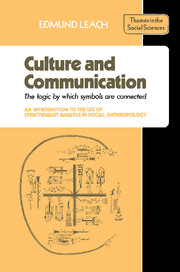 Culture and Communication
Culture and Communication Book contents
- Frontmatter
- Contents
- Culture and communication: the logic by which symbols are connected
- Introduction
- 1 Empiricists and rationalists: economic transactions and acts of communication
- 2 Problems of terminology
- 3 Objects, sense-images, concepts
- 4 Signals and indices
- 5 Transformations
- 6 Theories of magic and sorcery
- 7 The symbolic ordering of a man-made world: boundaries of social space and time
- 8 The material representation of abstract ideas: ritual condensation
- 9 Orchestral performance as a metaphor for ritual sequence
- 10 The physiological basis of sign/symbol sets
- 11 Mapping: time and space as reciprocal representations
- 12 Rank order and orientation
- 13 Examples of binary coding
- 14 Mating prescriptions and proscriptions
- 15 Logic and mytho-logic
- 16 Basic cosmology
- 17 Rites of transition (rites de passage)
- 18 The logic of sacrifice
- 19 Conclusion
- Bibliography
- Index
17 - Rites of transition (rites de passage)
Published online by Cambridge University Press: 05 June 2012
- Frontmatter
- Contents
- Culture and communication: the logic by which symbols are connected
- Introduction
- 1 Empiricists and rationalists: economic transactions and acts of communication
- 2 Problems of terminology
- 3 Objects, sense-images, concepts
- 4 Signals and indices
- 5 Transformations
- 6 Theories of magic and sorcery
- 7 The symbolic ordering of a man-made world: boundaries of social space and time
- 8 The material representation of abstract ideas: ritual condensation
- 9 Orchestral performance as a metaphor for ritual sequence
- 10 The physiological basis of sign/symbol sets
- 11 Mapping: time and space as reciprocal representations
- 12 Rank order and orientation
- 13 Examples of binary coding
- 14 Mating prescriptions and proscriptions
- 15 Logic and mytho-logic
- 16 Basic cosmology
- 17 Rites of transition (rites de passage)
- 18 The logic of sacrifice
- 19 Conclusion
- Bibliography
- Index
Summary
I have already remarked that most ritual occasions are concerned with movement across social boundaries from one social status to another, living man to dead ancestor, maiden to wife, sick and contaminated to healthy and clean, etc. The ceremonies concerned have the double function of proclaiming the change of status and of magically bringing it about (see Sections 7 and 11). From another point of view they are the interval markers in the progression of social time.
In a very broad sense all transition rites have a certain three-phase similarity of structure.
The initiate who is undergoing a change of status must first be separated from his (her) initial role. This separation may be represented in a variety of ways all of which may appear as part of the same ritual proceedings, e.g.
(a) the initiate may move in procession from position A to position B
(b) the initiate may take off his (her) original clothing
(c) sacrificial animals may be killed so that the life is separated from the carcase or sacrificial objects may be split in half
(d) surface ‘dirt’ of the initiate may be removed by ritual washing, shaving, etc.
In general these initial rites of separation have the effect of removing the initiate from normal existence; he (she) becomes temporarily an abnormal person existing in abnormal time.
Following the ‘rite of separation’ there follows an interval of social timelessness (see p. 34) which, as reckoned by the clock, may have a duration of a few moments or extend for months. Examples of the latter, more prolonged, kind of marginal state are the honeymoon of a Dride and the mourning of a widow.
- Type
- Chapter
- Information
- Culture and CommunicationThe Logic by which Symbols Are Connected. An Introduction to the Use of Structuralist Analysis in Social Anthropology, pp. 77 - 80Publisher: Cambridge University PressPrint publication year: 1976
- 1
- Cited by


